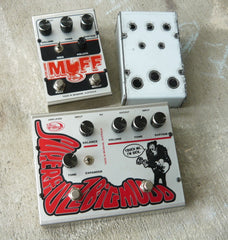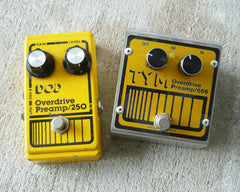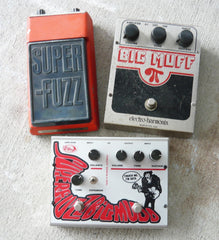Tym effects enclosures
Share
I get asked a lot, and comments when people actually see my pedals that they thought they were bigger so I thought I'd write a blog about the enclosures I've been using for some time now. These are the handmade stainless steel enclosures I use for alll the current Tym pedals.
Over the years I've used a few different enclosures including the standard "Hammond" cast aluminium ones that most manufacturers use. I used them early on but pretty quickly wanted my pedals to stand out from the crowd, so I started making my own boxes. The first Tym pedals were painted and a clear printed sticker applied under a few coats of clear paint. Next came the "Dogs Head" series with my hand made cast aluminium boxes that looked like .......... Dogs heads.
These proved difficult and time consuming to make so I moved onto screen printed Hammond boxes in this series. These lasted for a while but I was always wanting them to look different and make a mark aesthetically as well.

I started making these enclosures in 2009 with the help of a friend who ran a metal fabricating shop. They were squarely based on the old EH steel boxes and were exactly the same size as the original Little Big Muff series. They're a great little design and are a good size with heaps of room inside for making lots of different styles. We started making in these in runs of 10 tops and bases and these early ones were screwed together to get access to the battery, like the EH ones.
The first pedals I made in this style was the Screaming Mvff, which I was ........ asked to stop using the word MVFF and this one has a hand written date of 22/3/09 inside. It's serial #001.

The next pedal I made in this new style was in what I now call my "double pedal" but is actually the same size as a standard US BM. This was my homage to Mudhoney in the form of my Superfuzz Big Mud and I only made 10 of these, one of which is owned by Steve Turner from Mudhoney. This pedal "looks" big but is the same footprint as the BM, which is a big pedal but I usually use these for cramming lots into one pedal like the Earthless guitar and bass fuzzes or custom stuff for friends.

When I stopped using batteries in my effects I went to riveting the enclosures together as there was no longer a need to get inside and the rivets are stronger than the screws. The screws, over time, would always strip the holes out like old EH pedals eventually do so this was a more permanent way of assembling. Some people think I rivet them to stop people getting inside. It's really only 4 aluminium rivets and really not that hard to open, and since all my pedals have a lifetime warranty, I'm more than happy to open them back up if you ever have issues.
All (well, nearly all) the artwork for my pedals is done by my good friend Tone at Guitar Nerd who, I think, always does such a great job with anything I throw at him. He's certainly responsible for making Tym guitars "look" like it does. The artwork is printed on sticky backed aluminium plate and fixed to the front of the pedal, and then any holes relevant to that pedal is drilled through the aluminium face plate. The boxes are made with most of the holes needed for all the different pedals and the aluminium plate covers whatever holes aren't needed for the pedal being made.

Over the years this style of enclosure has served me well. I now make 5 different styles in the design. The original "portrait" style of the Screaming Mvff and a "landscape" version, which is the same footprint but sideways and the top slopping in the forward direction. This is now my most common style of pedal box with most of my Muds and variants using this style. It's a good size for working with and most of my PCB's have the correct pot spacing for this style. This is half the size of a regular Big Muff as well.

A new box was made when I started making the Fuzz Munchkin for J Mascis. Early prototypes were in my landscape slopped box but J wanted to know if I could make it lower to fit in a Fender hardcase pocket without the knobs keeping the lid up. I made a new "flat top" box in the same size as the slopped top especially for this pedal. This has now become the box I use for some of the signature pedals I do like the Munchkin and the Tatanka for Brett Netson. I also use it for me Tone Boost now as it's a great size for these while not being "too big" ?
The newest size is what I call my "mini pedals" and are any of the current pedals PCB's I can fit in this smaller enclosure. I did this for pedalboard real estate, which is at a premium now stomp boxes are back with a vengeance. Pedals are getting smaller and smaller with new surface mount and digital technology but most of this new, cheap stuff coming out isn't really repairable and sometimes you can make a pedal "too small" which I found out when I made my original Tone Boost, which was in a small Hammond style enclosure, sideways like some Zvex pedals. I loved it but big footed, inebriated guitarists asked me to make it bigger to move the stomps further apart.

I now get these enclosures laser cut and hand folded 100 at a time by a local metalworking shop as my friend wasn't set up to make that many at a time and bowed out. In the early days I made most of my pedals 5 at a time but the Munchkin changed all that for me. I make them 20 at a time and most of the others 10 in each batch. The pedals are still all handmade in my workshop by me. I get the PCB's printed and once they arrive I load them with the components. This is still a very time intensive exercise and there's still a lot of hand wiring involved in most of my designs, especially the more custom stuff. Luckily I find making pedals very therapeutic, when there's not too much pressure to keep them coming...
Check HERE to see all the different shapes, sizes and models.






